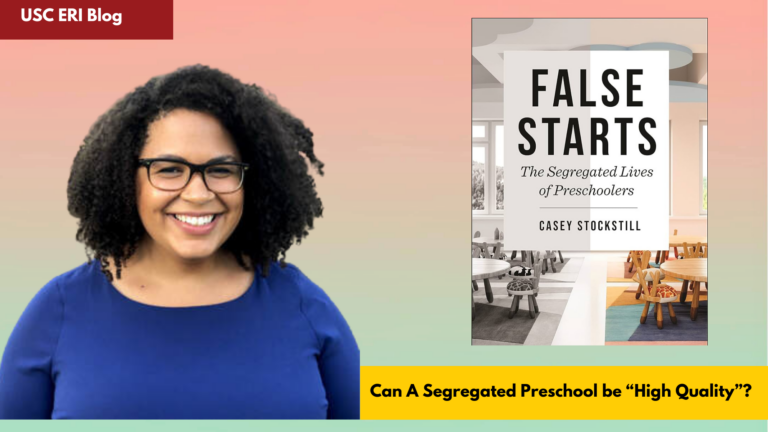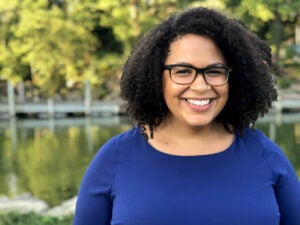
Can A Segregated Preschool be “High Quality”?
In the United States, attending preschool is neither required nor guaranteed. Yet more than 70% of 4-year-old children attend preschool. Many preschoolers are having their first experience of group learning and are relating to a peer group for the first time. Research shows that early, positive contact with people of other racial groups increases the chances of positive contact later on.
Rather than an early learning experience where children can make friends across race and class divides, two-thirds of preschoolers attend segregated preschools. That is, their classrooms are either majority affluent and white, or majority poor children of color. Preschools are more segregated than elementary schools, middle schools, and high schools. I spent two years closely observing children’s experiences in segregated preschools for my book, False Starts: The Segregated Lives of Preschoolers. I wanted to understand children’s perspective on their classrooms. I used something called the “least adult approach,” where I minimized my authoritative status as an adult. I avoided sanctioning, scolding, or instructing children. This allowed me to be partially accepted into children’s peer worlds.

At the start of my research on children’s experiences of preschool, I thought what mattered was that poor children and children of color could access classrooms rated as “high-quality.” I had an implicit understanding that preschools were segregated by race and class. I observed two classrooms, both rated among the top 10% of preschools in Wisconsin, but both highly segregated. One preschool, which I call Great Beginnings, served almost all white children, and all the students came from affluent families. The second preschool, which I call Sunshine Head Start, served almost all children of color, and all students were poor. I could see the influence of the layered expectations that a preschool must adhere to in order to be designated high quality. At both schools, the teachers had bachelor’s degrees and many years of experience. The schools used a play-based curriculum which is considered to be a best practice for preschool and their class sizes and teacher-student ratios that were well below the recommended benchmarks.
Segregation at Play
In accordance with recommendations for high-quality early learning, both preschools offered about an hour of indoor play. At Sunshine Head Start, most of the class played autonomously and the Sunshine Head Start teachers gave the children relative autonomy to control their activities. The children decided where, and with whom to play. When children finished with a play area—like the Block Area—they could clean up and choose where to play next. In this system, the kids developed their own peer-based system for starting pretend play with one another. They could also deal with newcomers to play and sort out conflict among themselves. Teachers were occupied with paperwork from fluctuating enrollment and tracking intervention programs designed to help children in poverty. The teachers also focused most of their attention on a handful of children with challenging behaviors—such as hitting, kicking, or biting. In many cases, children behaving in these ways were facing family disruptions like eviction, parental incarceration, or housing instability. Such disruptions happen more often to poor families and families of color.
Because I observed Head Start first, I thought the autonomy children had during indoor play was uniformly positive. The kids were developing creativity, independence, and problem solving. This is what I would think preschool is for.
Then I observed Great Beginnings where they also had an hour of indoor play. The Great Beginnings teachers were not dealing with fluctuating enrollment, or multiple children acting out. In the year I observed, the teachers said they had one child who had needed extra attention. But by February, the extra attention they gave this child had resulted in more predictable behavior from him. With their spare time, the teachers were highly involved in the kids’ play. They curated children’s playmates and used a timer system to have the children rotate through play centers. This encouraged well-rounded skill development, but it also prevented peer conflict and limited children’s creativity. While children played, teachers observed and commented on elements of what children did.
Children had vastly different experiences of “free play” in these segregated preschools. This was surprising to me, given that both preschools were designated as high-quality.
We imagine that preschoolers will enter kindergarten poised to take full advantage of learning and social opportunities. Yet my book shows that when preschool classrooms are segregated, they foster poor children’s sense of distance from teachers and encourage affluent children’s sense of entitlement to special attention from teachers.
The Transition to Kindergarten
After moving to kindergarten from their high-quality preschools, I worry about how the Sunshine Head Start and the Great Beginnings children will experience elementary schools. If the Sunshine Head Start children encounter elementary school classrooms that reward their creativity and problem-solving, they will benefit from how they learned to play in preschool. However, if they go to elementary schools that reward children who make requests and feel entitled to adult attention, the Sunshine Head Start children will be at a disadvantage compared to the Great Beginnings children.
My research has convinced me that, just like in other institutions of American life, separate cannot be equal. Designations of “quality” do not capture segregation or its many unintended consequences. Fortunately, preschool segregation is a fixable problem. Unlike K12 education in the United States, where we built out many school districts in a landscape of legal segregation, our preschool system is unfinished.
Expanding preschool access remains a popular policy and Head Start enjoys bipartisan support. As we increase funding and expand preschools, we can encourage class and race integration. We can also support programs that are segregated for the purpose of being culturally affirming learning spaces for children of color.
© 2024. This work is licensed under a CC BY-NC-ND 4.0 license.
 About the author: Casey Stockstill is an assistant professor of sociology at Dartmouth College. She is a race scholar and microsociologist. In her research, she uses ethnography, interviews, surveys, and experiments to investigate how micro-level interactions relate to institutional and structural inequalities. Casey’s research on preschool segregation has been supported by the National Science Foundation, the Ford Foundation, the Institute for Citizens & Scholars, and the Russell Sage Foundation.
About the author: Casey Stockstill is an assistant professor of sociology at Dartmouth College. She is a race scholar and microsociologist. In her research, she uses ethnography, interviews, surveys, and experiments to investigate how micro-level interactions relate to institutional and structural inequalities. Casey’s research on preschool segregation has been supported by the National Science Foundation, the Ford Foundation, the Institute for Citizens & Scholars, and the Russell Sage Foundation.